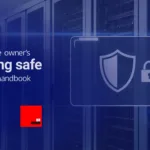- 1. The growing website security threat of cyberattacks in the UK
- 2. Common website security vulnerabilities
- 3. Essential website security measures
- 4. Protecting user data and GDPR compliance
- 5. Dealing with a website security breach
- 6. The role of your web developer in website security
- 7. More information about website security
In today’s rapidly evolving digital landscape, a strong online presence is essential for businesses across the United Kingdom. However, the increased reliance on the internet also brings significant challenges. Specifically, it exposes businesses to a continuously growing array of cyber threats. For this reason, robust website security is an undeniable necessity. Protecting your website, along with the sensitive customer data it holds, is paramount for maintaining trust, upholding your reputation, and ensuring the uninterrupted continuity of your business operations. Neglecting website security can lead to devastating consequences, from financial losses to legal repercussions.
The growing website security threat of cyberattacks in the UK
Cyberattacks continue to escalate at an alarming rate. Indeed, businesses throughout the UK are increasingly becoming prime targets for sophisticated and opportunistic malicious actors. These attacks can manifest in various forms, ranging from debilitating data breaches and insidious ransomware to distributed denial-of-service (DDoS) attacks and phishing scams. Each type of attack carries the potential for significant financial repercussions and severe damage to a company’s hard-earned reputation.
Often, small and medium-sized enterprises (SMEs), in particular, find themselves disproportionately vulnerable. They frequently lack the extensive financial resources and the robust security infrastructure that larger corporations might possess. Consequently, cybercriminals consider them easier targets. Furthermore, the true cost of a data breach extends far beyond the immediate technical fix. It can encompass substantial regulatory fines, especially under strict data protection laws like GDPR, significant lost revenue due to operational downtime, the often irreparable erosion of customer trust, and long-term damage to your brand’s integrity. According to recent reports, the average cost of a cyberattack for UK businesses continues to rise, highlighting the urgent need for proactive website security measures. A single incident can jeopardise years of hard work and investment.
Common website security vulnerabilities
Many websites, unfortunately, harbour inherent weaknesses that cybercriminals are adept at identifying and exploiting. Understanding these common vulnerabilities is the first step toward fortifying your website security.
Outdated software, plug-ins, and themes: A website security home goal
Firstly, outdated software stands out as a prevalent entry point for attackers. Your website’s content management system (CMS), such as WordPress or Joomla, can contain known vulnerabilities if you don’t regularly update it, along with its associated plug-ins and themes. These are essentially open doors that hackers can walk right through. Cybercriminals constantly scan for these unpatched flaws, knowing they offer easy access.
Weak passwords: A leading threat to website security
Secondly, weak passwords continue to pose an enormous risk to website security. Employees or even site administrators might use simple, easily guessable passwords or, worse yet, reuse the same password across multiple online accounts. This lax approach makes it incredibly easy for attackers to gain unauthorised access through brute-force attacks or credential stuffing. Strong password policies and multi-factor authentication (MFA) are critical defences.
Injection vulnerabilities: The weakness of code
Moreover, injection flaws, most notably SQL injection, represent a severe threat. These attacks allow criminals to inject malicious code into input fields on your website, manipulating your database to steal sensitive information, alter data, or even take complete control of your system. Similarly, cross-site scripting (XSS) attacks involve injecting malicious scripts into web pages viewed by other users. These scripts can then steal session cookies, deface websites, or redirect users to malicious sites, compromising both your website and its visitors.
Other critical vulnerabilities
Other critical vulnerabilities include broken access control, where users can access information or functions they shouldn’t, and security misconfiguration, which stem from improperly set up servers, applications, or network devices. Each of these vulnerabilities represents a potential weak link in your overall website security posture.
Essential website security measures
Implementing some simple website security measures can dramatically reduce your exposure to cyber threats and provide a strong defence. Proactivity in this area is key to safeguarding your digital assets.
SSL/TLS certificates
First and foremost, an SSL/TLS certificate is absolutely crucial for any modern website. This technology encrypts all data transmitted between your website’s server and your visitors’ browsers. This encryption protects sensitive information, such as login credentials, credit card numbers, and personal data, from being intercepted by malicious parties. Furthermore, the presence of “HTTPS” in the browser bar and a padlock icon signals to your users that your site is secure, building trust and positively impacting your search engine rankings. It is a cornerstone of effective website security.
Firewall
Secondly, a robust web application firewall (WAF) acts as an intelligent barrier between your website and the internet. A WAF monitors and filters HTTP traffic, identifying and blocking malicious requests before they can reach your web server. It can protect against various attacks, including SQL injection, XSS, and DDoS attacks, offering a vital layer of proactive website security.
Software updates
Regular software updates are also vital to maintain strong website security. Always ensure that your CMS, along with all installed themes and plug-ins, is kept fully up to date. Developers frequently release updates that patch newly discovered security holes and vulnerabilities. Delaying these updates leaves your website exposed and an easy target for exploitation.
Use strong, unique passwords
Moreover, strong, unique passwords for all administrator accounts, databases, and hosting panels are absolutely essential. Consider using a reputable password manager to generate and store complex, unique passwords for every service. Implementing multi-factor authentication (MFA) adds another useful layer of website security. MFA requires users to provide two or more verification factors to gain access, significantly reducing the risk of unauthorised entry even if a password is compromised.
Regular backups
Finally, regular and reliable backups of your entire website data are necessary. In the unfortunate event of an attack, data corruption, or server failure, having recent backups allows you to quickly restore your site to its pre-incident state, minimising downtime and data loss. Store these backups securely and off-site in different locations. Also, check them regularly to ensure they can be restored. For more comprehensive information, you might find our article, Website hosting UK: What you need to know, helpful in understanding data resilience.
Protecting user data and GDPR compliance
Protecting user data is not merely a matter of good business practice; it is also a stringent legal requirement, particularly in the UK and the wider European Union and European Economic Area. The General Data Protection Regulation (GDPR) sets forth comprehensive and strict rules for how personal data must be collected, processed, stored, protected, and deleted. All UK businesses that handle personal data of EU or UK citizens must comply with GDPR, regardless of where the business is located.
Actions and requirements of GDPR
GDPR compliance necessitates several key actions. Firstly, you must obtain clear and explicit consent from individuals before collecting their personal data. This means more than just a pre-ticked box; consent must be freely given, specific, informed, and unambiguous. Secondly, you are required to provide clear and easily accessible privacy policies. These policies must detail what data you collect, why you collect it, how you use it, who you share it with, and how individuals can exercise their rights regarding their data. This transparency is a cornerstone of GDPR.
Furthermore, you must implement appropriate technical and organisational security measures to protect this data from unauthorised access, loss, or destruction. This directly ties back into the broader concept of website security. Strong encryption, access controls, pseudonymisation (the replacement of an identifying datum with a pseudonym to separate personal identification data from general use in a system), and regular security audits are all part of this obligation.
Individual’s rights
GDPR also grants individuals a number of rights concerning their data, including the right to access their data, the right to rectification, the right to erasure (the ‘right to be forgotten’), and the right to restrict processing. Your business must have processes in place to facilitate these requests.
Failure to comply
Failing to comply with GDPR can result in extremely hefty fines, which can be up to 4% of your annual global turnover or €20 million, whichever is higher. Moreover, non-compliance can severely damage your brand’s reputation and lead to a significant loss of customer trust. For an in-depth look, read our article on GDPR compliance for websites (coming soon).
Dealing with a website security breach
Even with the most robust website security precautions in place, a breach can unfortunately still occur. Knowing how to respond effectively and efficiently is absolutely vital to mitigate damage and recover swiftly. A well-defined incident response plan is an essential component of comprehensive website security.
Detection and containment
Firstly, immediate detection is crucial. Modern monitoring tools and systems can alert you to suspicious activity. Once you detect a potential breach, the priority is containment. Isolate the affected systems or sections of your website immediately to prevent the attack from spreading further across your network or impacting more data. This might involve taking your website offline temporarily or segmenting your network.
Assess the scope and damage of the breach
Next, you must thoroughly investigate the breach. Understand its scope, how the attackers gained access, what data was compromised, and what actions they took. This phase, often requiring forensic analysis, helps you identify the root cause and learn valuable lessons for future website security.
Eradication
Following investigation, the next step is eradication. This involves removing the threat completely. It means patching vulnerabilities, cleaning compromised files, and eliminating any backdoors or malicious code left by the attackers. Make sure you change all compromised credentials to avoid a repeat.
Recovery
Subsequently, focus on recovery. Restore your website and systems from clean, uncompromised backups. Carefully monitor the systems to ensure you have fully eradicated the threat and that normal operations can resume safely. This stage requires meticulous attention to detail to avoid a re-infection.
Post-incident analysis
Finally, and crucially, conduct a post-incident analysis. Learn from the breach to identify weaknesses in your website security posture and implement stronger measures to prevent similar incidents in the future. This continuous improvement loop is vital for long-term website security.
Reporting and record-keeping
Remember that, under GDPR, you may have a legal obligation to report certain data breaches to the relevant supervisory authority and to affected individuals within 72 hours. This rapid notification is a critical aspect of your incident response. Considering your legal obligations and the regulatory framework, it is a good idea to keep full records of every incident, and even of your security audits and backup regimen.
The role of your web developer in website security
Your web developer plays a significant role in the overall website security of your online presence. They are not just responsible for the aesthetics and functionality of your site; they are key guardians of its underlying safety.
Using secure coding practices
A reputable web developer should implement secure coding practices from the very outset of development. This includes validating all user input, properly sanitising data, securely managing sessions, and using secure APIs. They should be knowledgeable about common vulnerabilities and actively build defences against them.
Checking your server is secure
Furthermore, your developer should ensure your website’s hosting infrastructure is robust and configured securely. This relies on your web developer being responsible for setting up your hosting package for you. This often means choosing a hosting provider with strong website security features, regular backups, and DDoS protection. It also means setting up your server space correctly, in terms of DNS records and basic security measures.
Further website security and maintenance
Depending on whether or not you have a maintenance contract with your developer, a good developer will continue to proactively recommend and implement crucial security updates for your CMS, themes, and plug-ins as soon as they become available. They will also advise you on best practices for password management and access control. Regular security audits, performed by your developer or a third-party specialist, can identify potential vulnerabilities before malicious actors can exploit them. These audits involve checking for misconfiguration, outdated software, and potential backdoors.
Moreover, your developer can help you understand the more technical aspects of website security, explaining complex issues in an understandable way. They can assist in setting up security monitoring tools, implementing Web Application Firewalls, and configuring secure server settings.
This is why establishing an ongoing website maintenance agreement with your developer is also highly recommended. It ensures consistent and routine website security checks, updates, and vulnerability assessments to maintain your website security. For more on this, please refer to our article on Website maintenance: Essential for UK businesses.
When choosing a developer, inquire about their security protocols and experience in building secure websites. For businesses looking to establish a strong online foundation, our complete guide, Website development UK: A complete guide for businesses, provides valuable insights.
Secure your website and business. Talk to Redcentaur about robust website security solutions.
More information about website security
Website development UK: A complete guide for businesses
Download our free security handbook, Staying safe: A website owner’s security handbook (50-pages).
Website hosting UK: What you need to know
Website maintenance: Essential for UK businesses
Read our article on GDPR compliance for websites. (coming soon)





